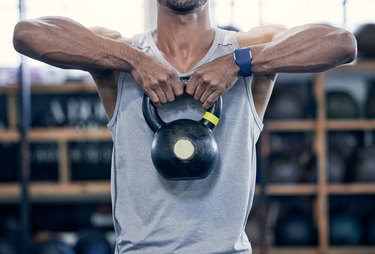
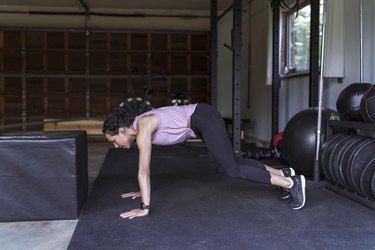

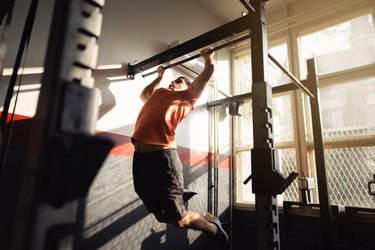
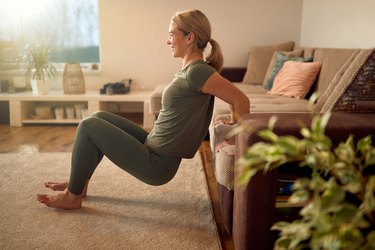
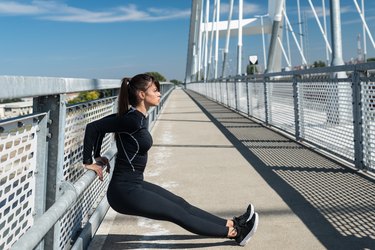


Let's be totally transparent: There are some exercises that just look cool — or are just so common they feel like a workout requirement. But that doesn't mean they're actually good, or that fitness professionals recommend you do them.
There are actually a few exercises out there that most trainers absolutely refuse to do — and they may even be in your usual workout routine. Read on to learn the six exercises personal trainers won't do and what you can swap them with instead.
Video of the Day
1. Upright Row

An upright row is a popular shoulder exercise that involves pulling a barbell, set of dumbbells or kettlebell up toward your chin, leading with your elbows. And although it's a relatively popular move, it's not one that Mathew Forzaglia, CPT, a New York-based personal trainer, likes to include in his workouts.
This exercise can put you at risk of shoulder impingement (nerve pinching), especially if you don't sit and stand with the best posture (which is the case for most people), he says. When you stand with poor posture, your shoulders rotate inward, particularly if you have tight chest muscles from sitting throughout the day.
But even for those with perfect posture, the position of this exercise increases your risk of shoulder pain and injury, Winnie Yu, DPT, a New York-based physical therapist and personal trainer, tells LIVESTRONG.com.
Swap It
There are a handful of alternative shoulder exercises that are safer on these sensitive joints, while targeting your shoulder muscles, Forzaglia says. Shoulder scaptions, for one, are safe on your shoulders but still get the muscle-building job done.
Dumbbell Scaption
- Stand with a dumbbell in each hand, arms at your sides, palms facing in.
- Brace your core and lift the dumbbells in front of your body at about a 45-degree angle.
- Raise the weights until they're slightly above shoulder height.
- Lower the weights back down with control.
2. Burpee

Although many high-intensity interval workouts sprinkle in plenty of burpees, they're another move Forzaglia prefers to keep out of his training sessions. While they do a great job at spiking your heart rate, they're easy to mess up (especially as you fatigue), which can cause strain or injury in your lower back.
"Burpees can be an injury waiting to happen," according to Carolina Araujo, CPT, a California-based certified personal trainer and strength coach. "Most people speed through them and end up using poor form. Plus, they put a lot of pressure on your joints every time you drop to the floor."
For those set on keeping burpees in their cardio workouts, try slowing down the exercise to focus on form. Considering the exercise has so many components, chances are, your heart rate will still get plenty high.
Swap It
Instead of burpees, Forzaglia prefers squat thrusts (aka dumbbell thrusters) because they're easier on your back, while still engaging your entire body.
Dumbbell Thruster
- Stand with your feet just wider than hip-width apart, core engaged, with a dumbbell in each hand held at your shoulders, palms facing in.
- Keeping your chest tall and core tight, hinge your hips back and down to sink into a squat. Lower until your thighs are parallel with the ground — or as low as you can comfortably squat while maintaining good form.
- Press through all four corners of your feet to return to standing.
- As you straighten your legs, press the dumbbells up over your head. Your upper arms should stay close to your ears.
- Slowly bend your elbows to lower the dumbbells back down to your shoulders with control.
3. Curtsy Lunge

"I hate curtsy lunges with a fiery passion," Forzaglia says. The reason? When you do the side (lateral) step in this exercise, your foot stays planted while your knee twists inward. Most people don't have the ankle mobility or knee stability needed to support their weight during this motion, he says.
Often, doing this move with poor form can cause knee or ankle issues, especially if you add extra resistance, like dumbbells.
Even for those who have good form and ample mobility, a lot of people do this move too quickly, Araujo says. "Momentum helps make curtsy lunges a lot easier, which can defeat the purpose completely because you don't build as much muscle."
Swap It
Forzaglia prefers the lateral lunge. This move is more efficient, targets the same muscles and is easier on the joints for most people. Instead of lunging with your leg behind you (as in a curtsy lunge) a side lunge involve simply stepping out to the side with one leg, bending your knee to 90 degrees and returning to standing.
Lateral Lunge
- From standing, root your right foot into the ground and step your left foot out to the side.
- Bend your left knee, keeping it in line with your left foot. You can have your hands on your hips or hanging on either side of the bent leg.
- Push off your left leg and return to standing.
- Do all your reps on the left leg before doing the same number of reps on the right leg.
4. Triceps Dip

Triceps dips are a not-so-safe exercise that Araujo likes to keep far away from her (and her clients') upper-body workouts. For most people (even trainers), dips go beyond a comfortable, safe range of motion. This makes your shoulder joint unstable while lifting your body weight, putting you at a higher risk of injury.
Plus, a lot of people don't have the strength needed to do the move correctly, according to Sam Becourtney, DPT, CSCS, a New York-based physical therapist. Your shoulder joints are sensitive and rely on the muscles around them for stability. When you don't have the necessary strength, dips can cause shoulder pain or iunjury.
Swap It
Instead of dips, Araujo likes to train her triceps with skull crushers. This exercise involves lying flat on your back with a pair of dumbbells straight up above your shoulders. Then, keeping your elbows in place, you lower the weights down to your ears.
"This move is a lot safer for your shoulders and isolates the triceps," she says. "Start with lighter weights, like 5 pounds, until you nail your form."
Dumbbell Skull Crusher
- Lie on a weight bench with your back flat against it. Hold a dumbbell in each hand, shoulder-width apart, palms facing inwards.
- Straighten both arms so the weights are at eye level and brace your core.
- Keeping your elbows tight, lower both dumbbells as far as comfortable.
- Once you feel a squeeze in your triceps, pause, then extend your elbows to raise the weights back to the starting position.
5. Crunch

You probably see some form of crunches in nearly every ab workout you find online, Araujo says. But they're a lot more ineffective than you may think, which is why she likes to leave them out of her workouts.
Not only do crunches fail to build much core strength, but they can cause you to strain in your neck and back, according to Yu.
"Although crunches are commonly seen as a fundamental core exercise, I personally would never do crunches or prescribe them to my clients because it is so easy to crane your neck while doing them," Yu says. "They can also feel uncomfortable on your lower back each time you press your spine into the floor."
Swap It
"I prefer planks to crunches any day of the week," Araujo says. Planks are safer and help target the deeper core muscles that help support your back, too. When she wants a little extra oomph in her ab workouts, she also tries a few challenging variations, like side planks or rotating planks.
Plank
- Lie face down on your belly with your palms on the floor underneath your shoulders and your feet flexed with the bottoms of your toes on the floor.
- Take a deep breath and press through your palms to lift yourself up into the top of a push-up position. Your body should make a straight line from your heels through your hips to the top of your head.
- Draw your navel toward your spine and squeeze your glutes.
- Look at the floor directly below your head to keep your neck in a neutral position, and breathe normally.
- Hold for at least 10 seconds and lower yourself back to the floor.
6. Kipping Pull-Up

Kipping pull-ups aren't too common around traditional weight rooms, but you may see plenty of them in CrossFit boxes. Although they look pretty cool (imagine hanging from a bar and using your body to swing up into a pull-up), they're usually an injury waiting to happen, according to Yu.
The flailing motion puts a lot of stress on your shoulder joints, which are sensitive as it is, Araujo says. Even for those with strong, mobile shoulders, flailing your body while your shoulders support your entire weight is often too much to handle.
This move also demands a lot of strength from your back, she says. So, if you don't have enough strength or perfect form, back pain or injury is pretty common, too.
Swap It
Yu recommends traditional pull-ups instead. They may not look as intense but they still give you all the strength-building benefits of kipping pull-ups without the risk of injury across your body. Plus, since standard pull-ups don't involve a swing, you need to rely on your core strength to help pull yourself up.
Pull-Up
- Hang from the bar with an overhand grip (palms facing away from you), hands about shoulder-width apart.
- Keep your shoulders back and down. Pull your chin toward the bar by bending your elbows.
- To help engage your back, concentrate on bringing your elbows down to touch your lats instead of thinking about bringing your chin over the bar.
- Return to the start position, and repeat.